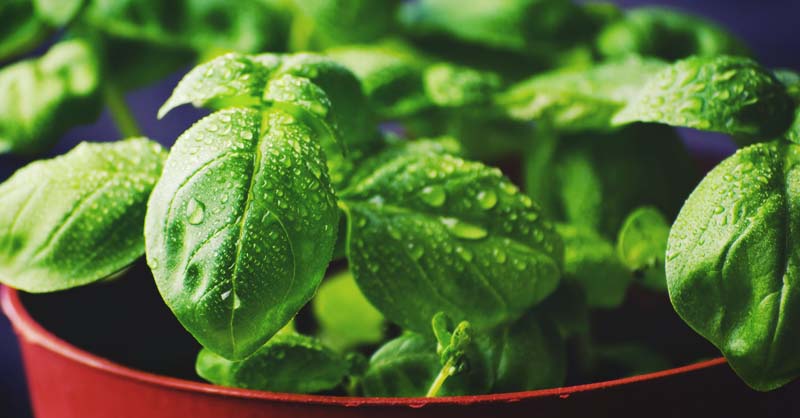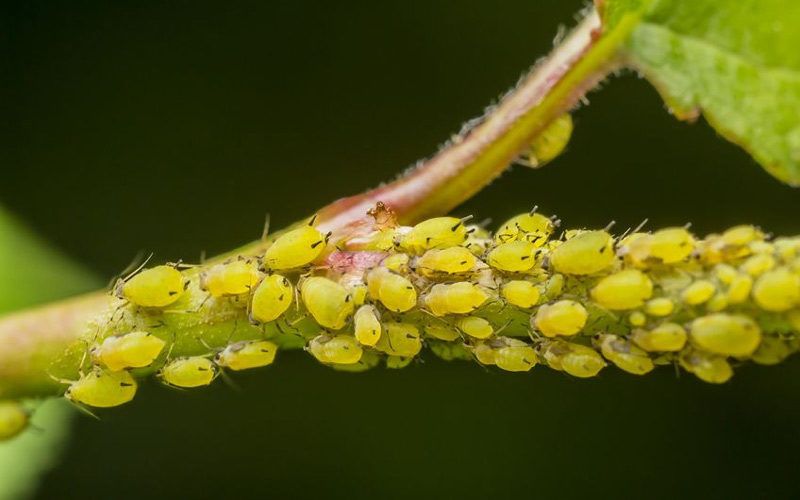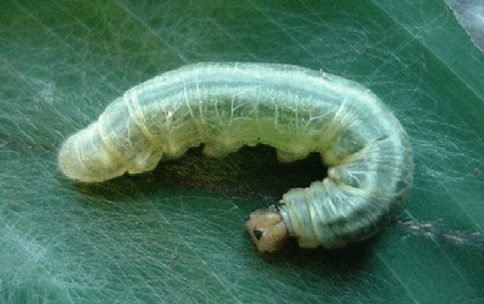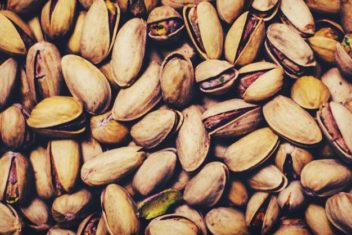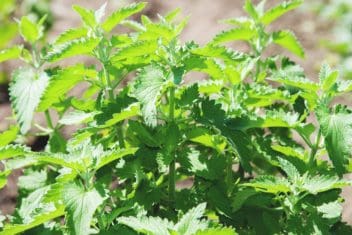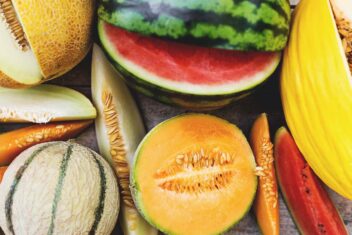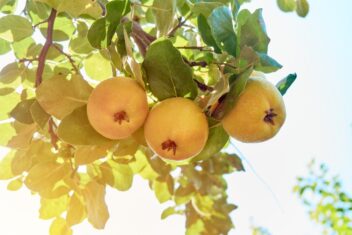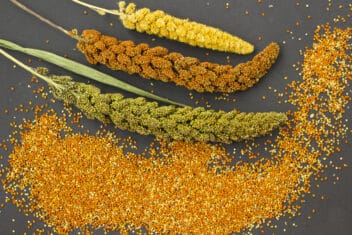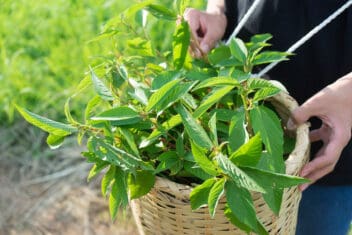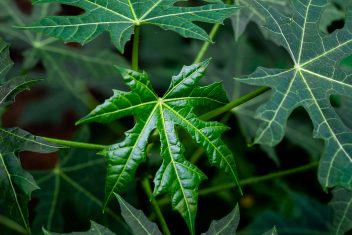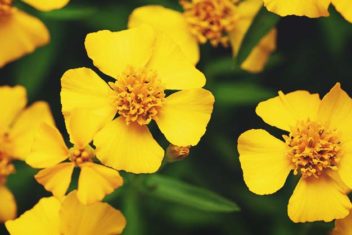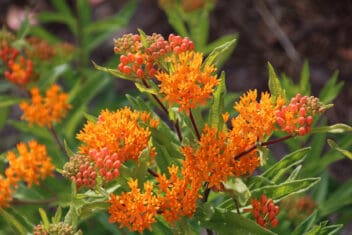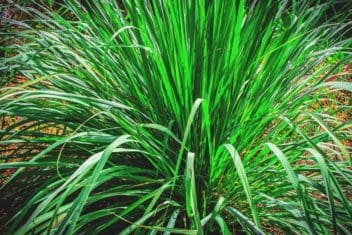Basil is one of the herbs I’m obsessed with growing well. It has a unique aroma that fills the garden with a fresh, spicy scent that I can’t get enough of, and it lends dishes a subtle peppery flavor in all kinds of cuisines, from Italian to Thai. Like most herbs, it’s also healthy for you.
As if that wasn’t enough to recommend it, growing basil isn’t as challenging as some edible plants. This tropical native is happy to grow outside, inside, in the ground, in pots or even in a hydroponic system. Harvesting is simple, too. You can pluck the leaves when you want to use them, and it will keep sprouting new ones.
In fact, basil is so easy to grow and so useful around the house, I think it’s an essential plant for any garden (or windowsill) to have.
There are dozens of varieties to choose from, each with unique flavors and uses. This guide will help you pick the best for your home and make it thrive.
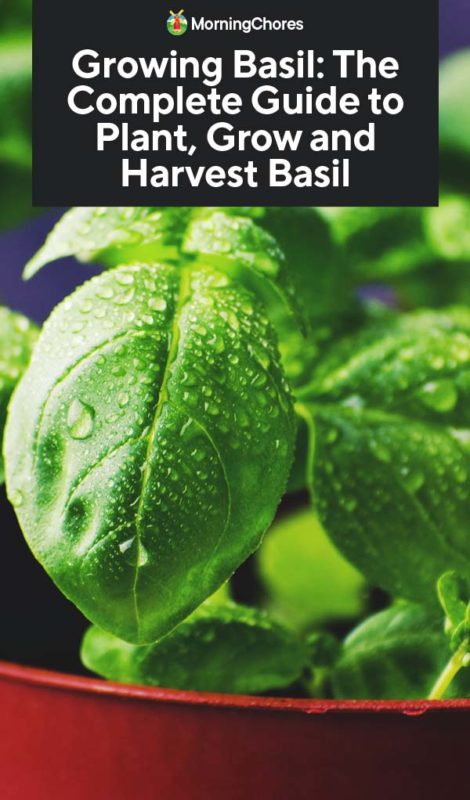
Basil Varieties
There are numerous types of basil and choosing one comes down to what you’re going to use it for and what your taste preference is. Some varieties are stronger tasting than others, and some are sweeter. Some are better for medicine, while others are perfect in pesto.
Sweet Basil
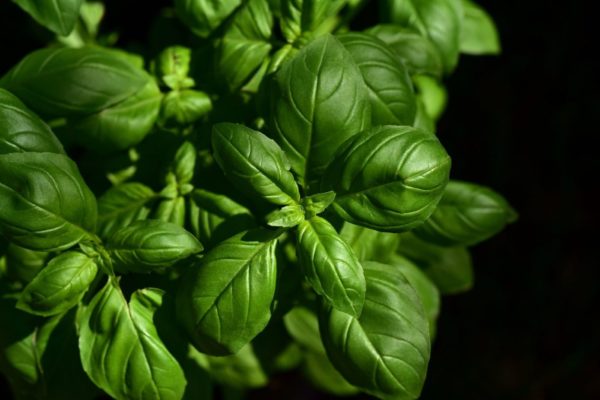
Sweet basil is probably the type most people associate with basil. It has large, smooth leaves that are bright green.
Genovese is one of the most common sweet basil varieties, and it’s often the one you see in the grocery store. As you’d expect from the quintessential Italian basil, it’s lovely in pesto and with tomato. This variety is ideal if you are new to growing basil because it’s not fussy. It has good leaf production and a robust clove-like flavor. It takes 60 to 90 days to mature and reaches about 24-inches tall.
Lettuce basil grows large leaves that can get as big as your hand. It takes about 75 days to mature and reaches 2-feet tall. It has a mild, sweet flavor.
Thai Basil
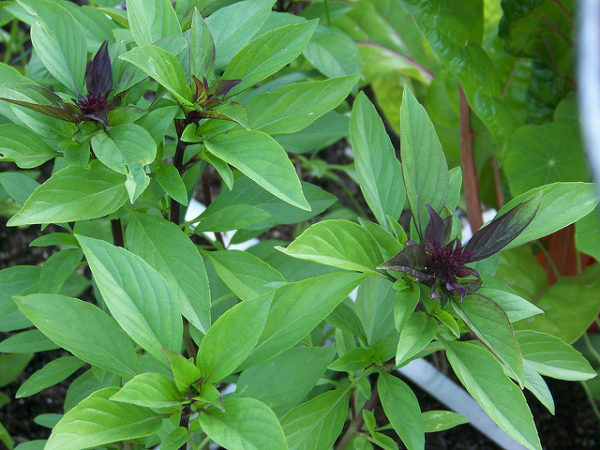
As the name suggests, this is the type often found in Thai cooking. It has a distinct licorice aroma and adds aniseed and clove flavor to dishes. Its leaves are more robust than Genovese basil so it can stand up to cooking in things like soup.
There are many different varieties of Thai basil, including Persian, which has a spicy lemon flavor. Siam queen is another variety featuring huge purple blossoms. Both mature in 60-90 days and reach 18-24 inches tall.
Purple Basil
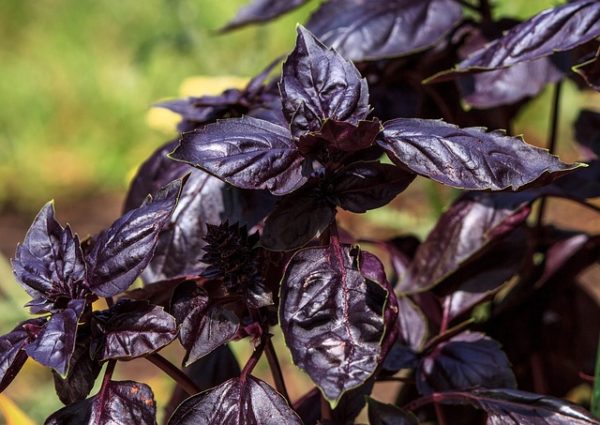
There are several types of purple basil, all featuring beautiful dark purple leaves and lilac flowers. The leaves smell sweet and lend nicely to vinaigrettes and salads.
Purple ruffles is a purple variety with a stronger flavor than you’ll find in sweet basil. As the name implies, it has serrated, rippling leaves that make a pretty addition to the garden. ‘Round midnight grows in a dense mound of fragrant, dark violet foliage. It grows 12-inches tall and 10-inches wide. Dark opal basil features dark red stems and lilac flowers. It grows about a foot tall.
Holy Basil
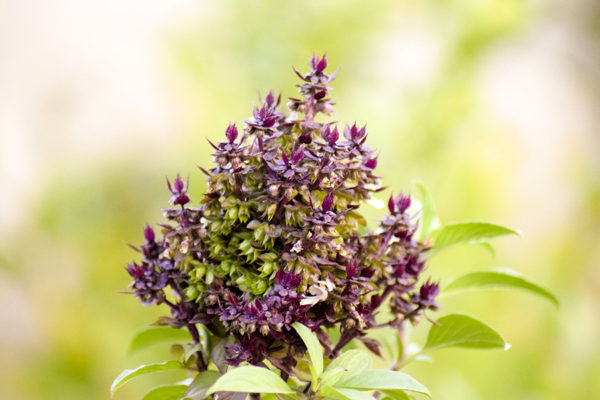
Also known as tulsi or sacred basil, holy basil is a versatile Southeast Asian variety can be used in various cooking styles, as a tea, in potpourri, and in medicine. Studies show that it may have numerous health benefits.
It has a strong camphor scent and matte leaves with a red undertone. It gets about 12-inches tall.
Lemon Basil
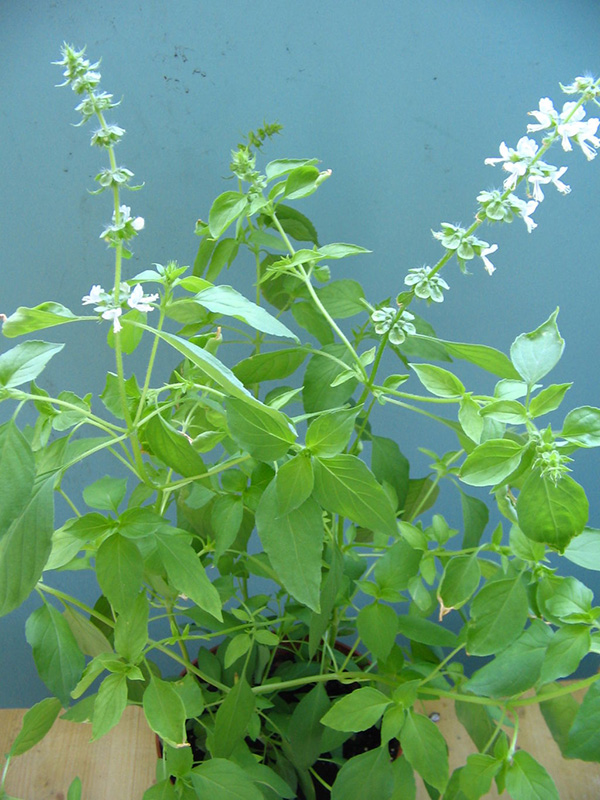
Lemon basil is an old fashioned heirloom variety that has an intense lemon flavor that goes nicely with fish or chicken. The plant features narrow, elongated leaves and lemon-scented white flowers. Grows to 18-inches tall and matures in 60-90 days.
Greek Basil
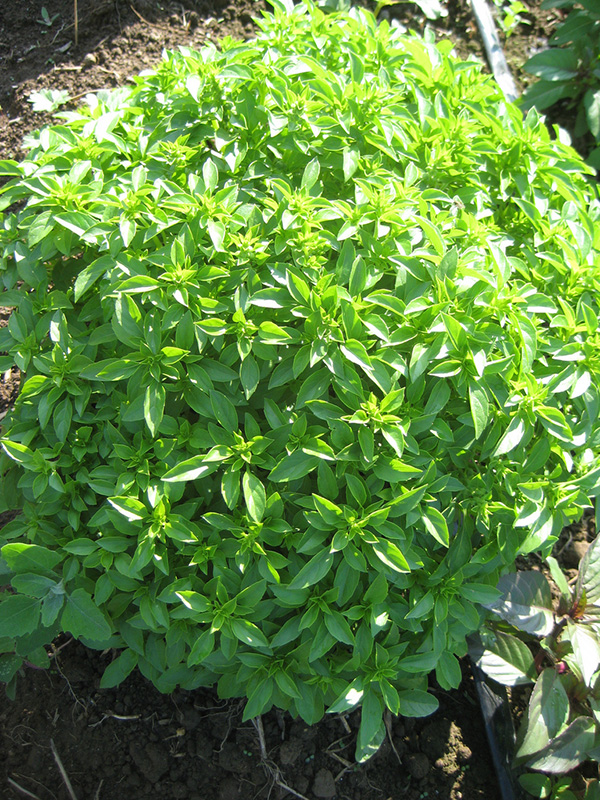
Also known as globe basil, this is an heirloom variety native to Southeast Asia. It has small leaves on compact, dome-shaped plants. It only gets about 8-inches tall, making it ideal for container growing.
African Blue Basil
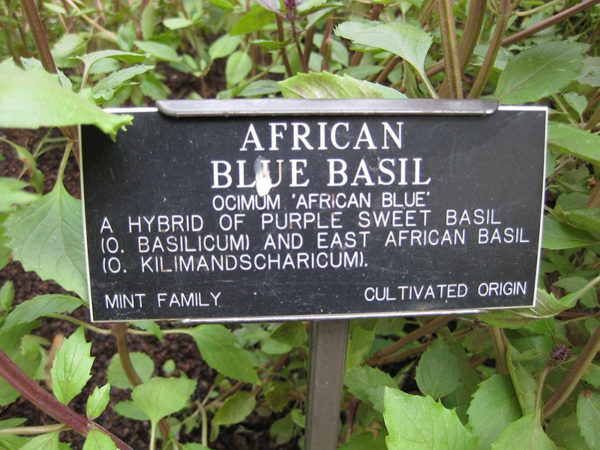
This hybrid stands out from other varieties because it can get huge for basil – up to 4-feet tall. It’s also a perennial in some areas. It produces sterile pink flowers and has a unique flavor.
Cardinal
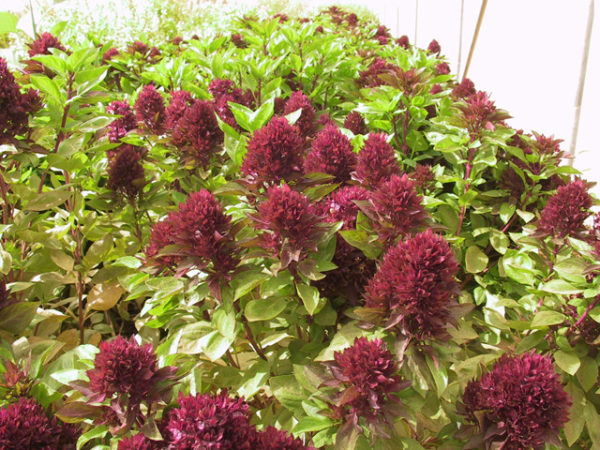
Growing basil doesn’t have to be just about producing food. Cardinal basil has beautiful red flowers that add color to the herb garden. You can eat the huge blossoms, but the leaves also have a delicious, spicy flavor. It grows up to 30-inches tall and matures in 60 days.
How to Plant Basil
Zones
Basil thrives in zones 4-10.
When to Plant Basil
When growing basil indoors for transplant, start them 4 to 6 weeks before the last frost date.
Plant outdoors in early spring as long as temperatures don’t drop below 50°F. If in doubt, plant in a greenhouse, tunnel house or inside. If the temperature drops below 39°F, basil will turn up its toes and die.
In most areas, you can plant in a pot on the windowsill any time for a year-round supply.
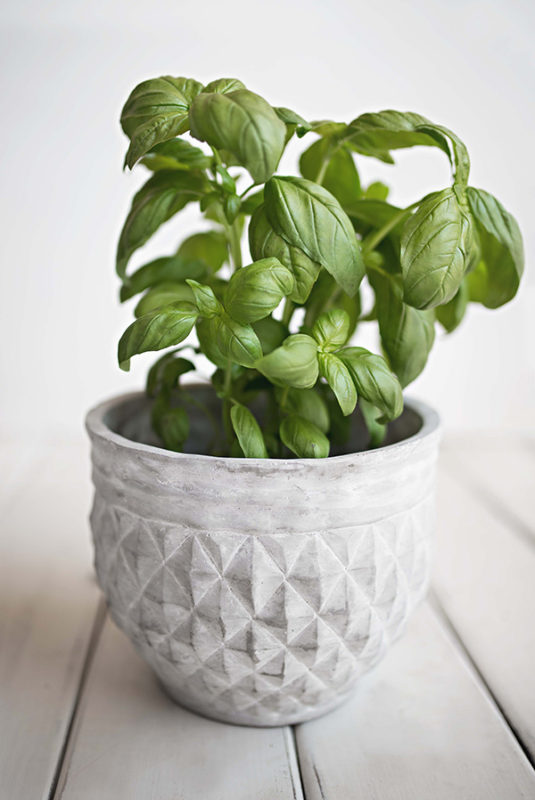
Direct Sowing
Sprinkle seeds outdoors in a prepared bed after the danger of frost has passed and soil is 50°F. Cover with soil 1/4-inch deep.
Growing Basil in Pots
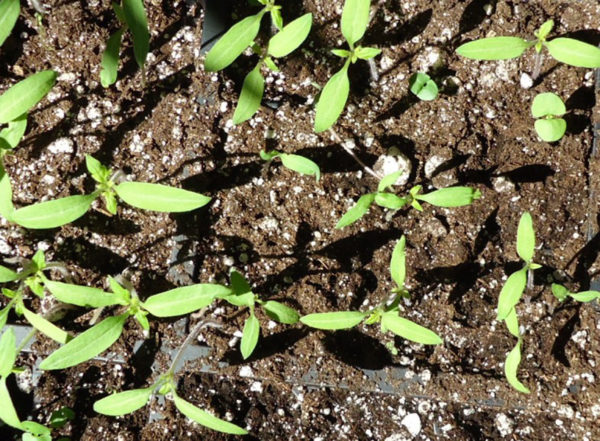
Fill pots with a good quality potting seed mix. Sprinkle liberally with basil seeds and cover with a thin layer of soil. Spritz soil with a spray bottle every day to keep moist.
Sun Requirements
Growing basil needs plenty of sunlight – about 6-8 hours per day. But while basil loves the sun, the leaves can scorch in intense light. If temperatures regularly rise above 86°F, give plants partial shade during the mid-day.
Soil Requirements
Basil prefers soil pH between 6-7. Ensure the soil is free draining and compost-enriched.
Spacing
Leave 12-inches between plants and 16-24 inches between rows. Remember that some basil can get tall, so don’t plant it next to low-growing veggies that may end up getting shaded.
Transplanting
Once the seedlings sprout and grow to at least 1.5 inches, transplant to your garden.
How to Care for Basil
Water Well
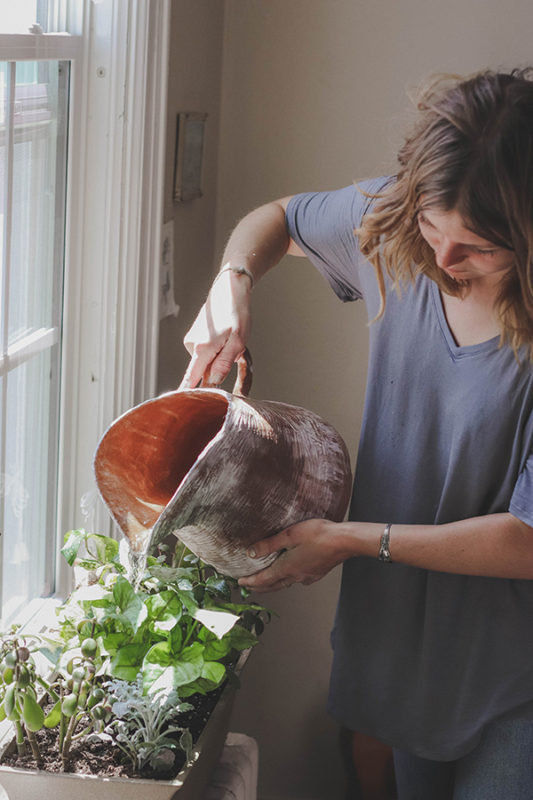
Growing basil needs regular water. You’ll know your basil is too thirsty if it starts drooping in the heat of the sun. Be sure to water at the base and not on the leaves, as the heat of the sun will scorch wet leaves to death.
Give at least 1-2 inches of water per week, allowing the soil to dry out in between waterings. Basil appreciates a good soak rather than frequent watering.
Protect from Wind
Basil doesn’t like wind, as it dries out quickly. Use a barrier that protects it from the wind, but doesn’t stop the sun getting to it.
Trimming
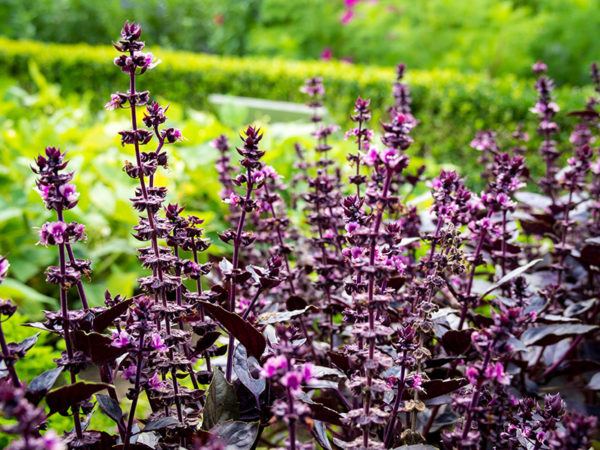
Basil is notorious for bolting to seed prematurely. This can be because of insufficient watering during a long hot summer. Dead-head the flowers to retain the flavor in the leaves.
The more you take, the more basil gives. Keep picking the leaves to keep the plant producing more. Sometimes the lifespan of the basil plant can be short, so harvest away, basil lovers.
Fertilizing
In general, basil doesn’t need fertilizer if you’ve planted it into well-composted soil. If it isn’t producing large leaves, you can add a balanced fertilizer every 4-6 weeks.
Weeding
Keep weeds at bay to prevent disease and bugs from attacking your growing basil plants.
Common Problems and Solutions for Growing Basil
If you feed and water correctly and plant in the right location at the right time, your basil should be a strong, healthy plant. That said, you may come across a few issues. Here are a few things to watch for and how to fix them.
- Wilted and Discolored Leaves – Basil requires a fair amount of nitrogen because you are using the leaves. Use a balanced liquid fertilizer if your leaves aren’t thriving.
- Stunted Growth – This is often a sign that the basil was planted too early and it suffered in the cold. It could also be a lack of nutrients.
- White Spots on Leaves – Your basil may be suffering from too much light. Basil loves sun, but not too much. Remember to use partial shade to your advantage.
Aphids
Aphids come in all shapes and sizes and love everything you love to eat. Unless you inspect your basil regularly, by the time you see the aphids, you have an infestation on your hands. Spray plants with a burst of water to knock aphids off and use neem oil to control them. I like neem oil because it makes the plant unattractive to the bugs over time.
Generally, neem oil isn’t an instant knock-down spray but takes a few applications over a month or so. I have mixed a little organic pyrethrum with the neem oil on occasion to provide a knock-down effect along with the extended impact of the oil.
Leaf Roller
Leaf rollers are probably the issue I have come across most often with basil. The moths like to lay their eggs on the underside of basil leaves. You can see them on plants, and they look like little white dots. You may also see basil leaves slightly curled inwards. This is because the caterpillar has cocooned itself by using the sides of the leaf as support.
If you have a light infestation, pick off the impacted leaves. Make sure you check the back of any leaves you pick to eat. I have nearly placed one of these in my pesto.
Cercospora Leaf Spot
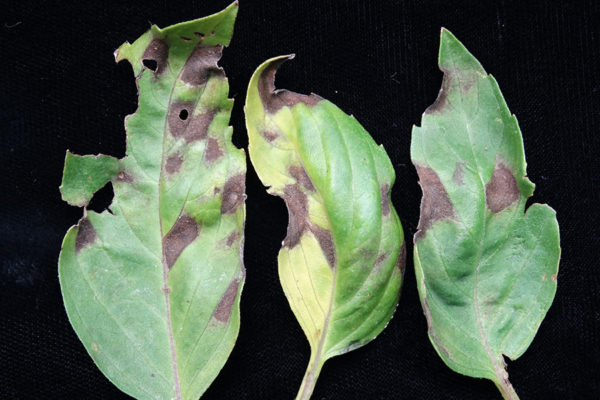
This fungus attacks leaves, resulting in a dark leaf spot with a white center. Avoid overhead watering, give plants plenty of room and remove infected leaves.
Downy Mildew
This disease is relatively new and causes yellowing on the upper side of growing basil leaves along with gray spores on the underside. Give plants plenty of space and avoid overhead watering if you struggle with downy mildew. Rotate your plants and toss any infected ones. There is no cure, but there is a new variety call ‘Amazel’ that is resistant.
Fusarium Wilt
If you see dark brown stem cankers that eventually cause the leaves to die, you may have fusarium wilt. Fusarium wilt is another newcomer to basil. There is no cure, so avoiding it is key. Use seeds that are certified free of the disease and pick resistant varieties like ‘Nufar.’ Water the soil, not the plant and give basil plenty of room. Toss any infected plants.
Gray Mold
Also known as Botrytis blight, this disease causes gray, soft spots on leaves, which may or may not be covered in a fungus. Eventually, plants will wither and die. It is spread by water, including mist, rain, and irrigation. Give basil plants plenty of space and mulch. Copper fungicides can help if your infestation is bad.
Root Rot
Also known as damping off, root rot is a fungal disease that prevents nutrients from reaching the leaves and can eventually kill a plant. Start with clean tools and soil and be sure not to overwater plants.
Slugs and Snails
Slugs love basil, and if you see that something has nibbled on your leaves, they’re the likely culprit. Hand pick them if you see them, place crushed oyster shells around plants, or use a slug trap.
Cutworms
Cutworms are caterpillars that like to snack on plants during dawn, dusk and cloudy days. They chew through plant stems at the base. You can use plant collars and hand picking to keep them under control. You can also apply diatomaceous earth around plants.
Flea Beetles
These hopping beetles can quickly destroy young basil plants. You’ll notice a wilted appearance and tiny holes in the leaves of your plant. Keep the weeds at bay and cover young growing basil plants with row covers. Till the soil in the fall to get rid of any developing larvae.
Japanese Beetles
Japanese beetles are 1/2 inch long with copper backs and blue-green heads. They attack in groups and can quickly decimate a plant. Hand-pick when you see them and use row covers in late spring and early summer. Neem oil can help reduce populations, as can traps.
Leafminers
This tiny insect leaves tunnels throughout basil leaves leaving trails behind that can become infected by fungus or bacteria. Squeeze the tunnels to crush any larvae, use row covers and sticky traps, along with a neem oil spray, to control the adults.
Companion Plants for Basil
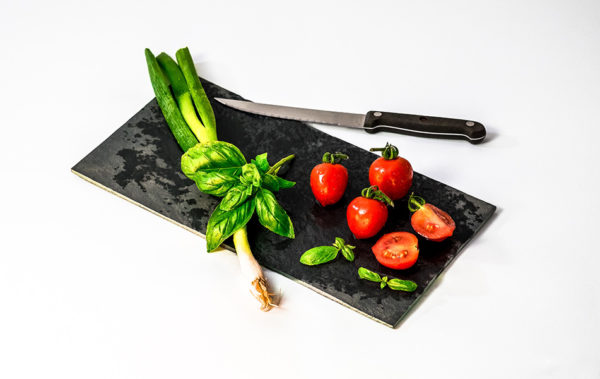
Some gardeners say that growing basil and tomato is the perfect garden combo. The tomatoes get a flavor boost from the basil, and the basil keeps pests away from tomato plants.
When you plant your tomato seedlings, scatter basil seeds around the tomato plants and cover lightly with soil. The beauty of this method is by the time you plant tomato seedlings the weather is warm enough for basil. As you water your tomato seedlings, the basil seeds are also getting what they need. If you plant basil with your tomatoes, you will feed the basil when you feed the tomatoes.
Come harvest time, what tastes better than tomato and basil? I pick a cherry tomato and wrap it in a basil leaf and eat as I harvest.
The best plants to pair basil with are:
Best Companions
- Tomato
- Bell Pepper
- Chilli
- Beets
- Oregano
- Marigolds
- Beans
- Asparagus
- Petunias
Worst Companions
- Rue
- Snap beans
- Cucumber
- Anise
How to Harvest and Use Basil
Seeds
If you plan on saving seeds, be sure to keep different basil varieties away from each other by at least 100 feet to avoid cross-pollination. To harvest seeds, snip the entire flower stalk once the pods start to brown. Place in a paper bag until the entire stem browns and give the bag a good shake to loosen the seeds.
Basil seeds aren’t only useful for starting new plants, you can eat them, too. Use them anywhere you’d use chia seeds.
Leaves
Pick the leaves as often as you can to encourage continuous growth. Be sure to harvest as you need them because basil doesn’t store well for long.
Harvest before cold weather sets in. Basil is an annual, so it won’t stick around over the winter. The leaves are better torn than cut with a knife as they blacken easily.
Keep fresh leaves in a plastic bag in the fridge for a short period. You can also preserve in olive oil or vinegar. Basil leaves are delicious dried and store in glass jars.
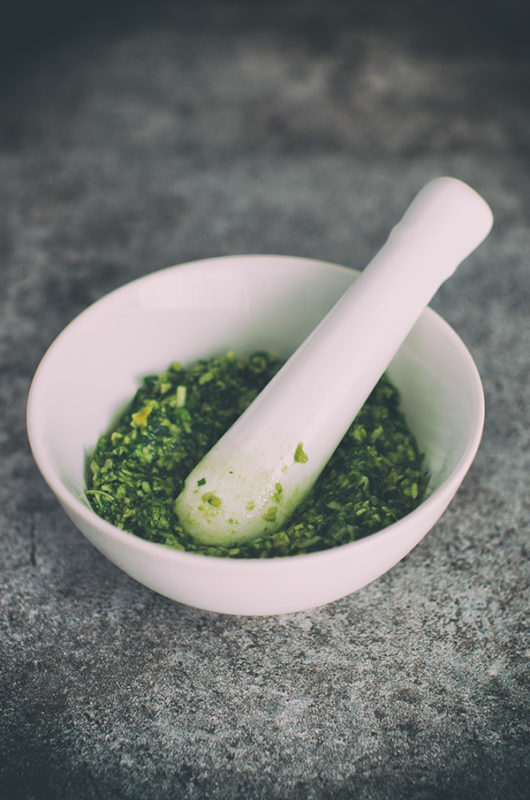
You can use basil in a wide variety of recipes. Pesto, salads, and pasta are obvious choices, but don’t forget desserts and drinks as well. Medicinally, basil can help with stomach issue and gas. It also has anti-inflammatory properties.
Basil is a delightful plant to grow. It tastes fantastic, looks beautiful in your garden and has so many uses. The best advice I can give is to have a go. You will be thankful you did when you are harvesting fresh leaves for all of your favorite recipes.
Hopefully, you found this post helpful, but I still want to hear from you. Do you have any tips and tricks for those that are new to growing basil? Do you have any great recipes to share with us on how to use your basil harvest?

